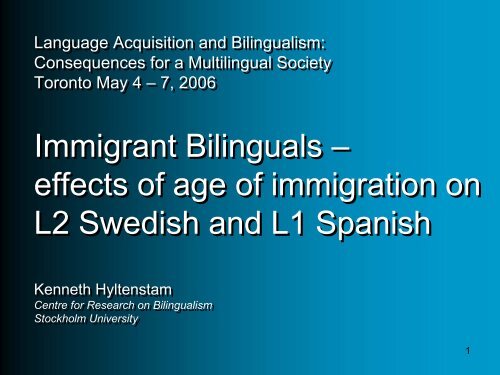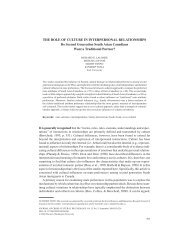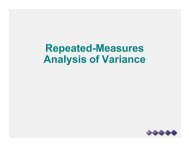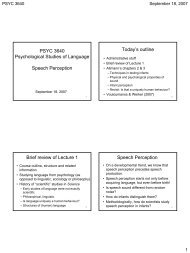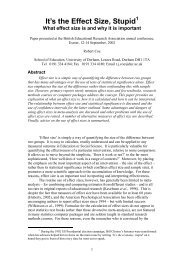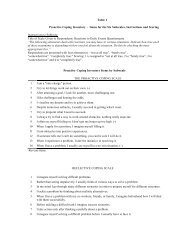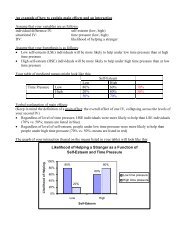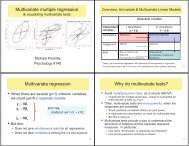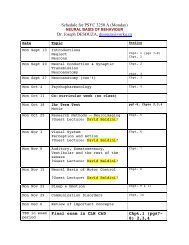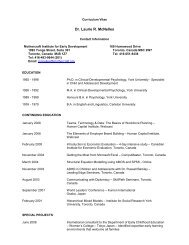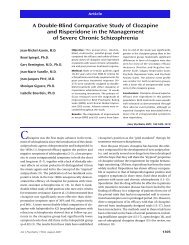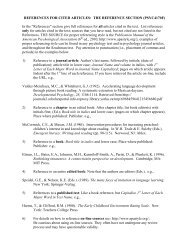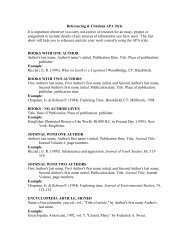Kenneth Hyltenstam
Kenneth Hyltenstam
Kenneth Hyltenstam
Create successful ePaper yourself
Turn your PDF publications into a flip-book with our unique Google optimized e-Paper software.
Language Acquisition and Bilingualism:<br />
Consequences for a Multilingual Society<br />
Toronto May 4 – 7, 2006<br />
Immigrant Bilinguals –<br />
effects of age of immigration on<br />
L2 Swedish and L1 Spanish<br />
<strong>Kenneth</strong> <strong>Hyltenstam</strong><br />
Centre for Research on Bilingualism<br />
Stockholm University<br />
1
Immigration to Sweden<br />
• 1940s, 1950s: Waves of refugees, incipient labour<br />
immigration from neighbouring countries<br />
• 1960s: labour immigration from southern and central<br />
Europe<br />
• 1970-: refugees, family connection cases<br />
Today<br />
≈12 % of the population of 9 million<br />
Most common countries of origin:<br />
Finland, former Yugoslavia, Iran, Norway, Iraq<br />
Most commonly spoken lgs of immigrant pupils: Arabic,<br />
Finnish, Spanish, Albanian, Persian<br />
2
Bilingualism at school<br />
• Right to mother tongue instruction since<br />
1977; ≈ 50 % participate at their own<br />
choice<br />
• Swedish as a second language since 1966<br />
• Implementation problems are salient.<br />
3
Age of onset and ultimate attainment in<br />
second language acquisition<br />
(The Bank of Sweden Tercentenary Foundation)<br />
<strong>Kenneth</strong> <strong>Hyltenstam</strong> (PI, project leader)<br />
Niclas Abrahamsson (PI)<br />
Katrin Stölten (SI, PhD student)<br />
Johan Roos, Gunilla Thunberg (assistants)<br />
First Language Attrition in Advanced Second<br />
Language Learners<br />
(The Swedish Research Council)<br />
Niclas Abrahamsson (PI, project leader)<br />
<strong>Kenneth</strong> <strong>Hyltenstam</strong> (PI)<br />
Emanuel Bylund, Katrin Stölten<br />
(SI, PhD students)<br />
Alejandra Donoso (assistant)<br />
4
Questions for this talk<br />
1. What is the rate of ”complete” SL acquisition among late learners?<br />
(Selinker, 1972: 5 %; Birdsong, 1999, 2005: 15%; Piller, 2005:<br />
45%; Bley-Vroman, 1989: 0 %)<br />
2. What is the rate among prepuberty learners? (<strong>Hyltenstam</strong>, 1992;<br />
Tsukada, Birdsong, Bialystok, Mack, Sung & Flege, 2005)<br />
3. What is the rate perceived nativelikeness?<br />
4. What is the rate of scrutinized nativelikeness?<br />
5. To what extent are these rates related to certain age of aquisition<br />
spans? Correlations with other background factors?<br />
6. Do patterns of L1 use correlate with degree of perceived or<br />
scrutinized nativelikeness in L2? (Flege et al. 1995; Pallier et al.<br />
2003; Ventureyra et al. 2004)<br />
5
Methodological outline<br />
1. Identification of candidates for nativelikeness<br />
2. Screening for nativelikeness<br />
3. Many complex tests and detailed analyses of<br />
nativelikeness<br />
6
Identification of nativelike candidates<br />
Advertisement 1 in Metro 16 September 2002<br />
125×182 mm<br />
• 135 candidates<br />
625 000–720 000<br />
readers per day<br />
Advertisement 2 in Metro 16 April 2003<br />
125×182 mm<br />
• 50 candidates<br />
Advertisement 3 in Aftonbladet<br />
15 March 2004, 250×100 mm<br />
• 10 (!) candidates<br />
325 000 readers per day<br />
7
Identification of nativelike candidates<br />
Six selection criteria:<br />
1. L1: Spanish<br />
2. speak Swedish like a native speaker<br />
3. ≥ 19 years old<br />
4. length of residence in Sweden: ≥ 10 years<br />
5. 12 years of education (minimum)<br />
6. speak the Stockholm variety of Swedish<br />
8
Telephone interview (recorded)<br />
Age of onset (AO) of acquisition of Swedish<br />
Present age (AGE)<br />
Length of residence (LOR) in Sweden<br />
Pattern and frequency of use of Spanish and Swedish<br />
Knowledge of other languages<br />
Longer periods away from Sweden / the Stockholm area<br />
Any known hearing impairment or dyslexia<br />
Handedness<br />
9
Speech elicitation<br />
Describe Astrid Lindgren and<br />
her books and characters for<br />
about one minute<br />
10
Background variables<br />
Background information (independent variables) on the 195 candidates; comparison<br />
between those with AO before and after puberty (df = 193).<br />
AO ≤ 11 years<br />
(n = 107)<br />
AO ≥ 12 years<br />
(n = 88)<br />
t-test<br />
Independent variable<br />
M<br />
SD<br />
M<br />
SD<br />
t<br />
p<br />
Chronological age<br />
28,6<br />
7,2<br />
41,5<br />
9,1<br />
–11.1<br />
< .0001<br />
Years in Sweden<br />
23,1<br />
7,5<br />
21,2<br />
7,3<br />
1.82<br />
> .071ns<br />
Years of L2 exposure<br />
22,4<br />
7,4<br />
20,9<br />
7,3<br />
1.41<br />
> .1, ns<br />
Daily L1 use (%)<br />
27,4<br />
17,5<br />
30,9<br />
18,1<br />
–1.34<br />
> .1, ns<br />
Sex (f/m)<br />
69/31<br />
61/39<br />
–1.14<br />
> .1, ns<br />
11
Screening experiments<br />
Three computerized screening experiments<br />
The first 20–30 sec. of the Astrid Lindgren descriptions<br />
… and descriptions over the telephone from 20 native<br />
speakers of Swedish (10 from Stockholm, 10 with subtle<br />
non-stockholmian features in their pronunciation)<br />
10 native Swedish judges per experiment (not linguists,<br />
phoneticians, etc.; no knowledge of Spanish)<br />
C. 45-90 minutes, SEK 100–150:- (≈ $13 – 20)<br />
12
Screening experiments<br />
I believe that this person:<br />
A. has Swedish as a mother tongue<br />
and comes from Stockholm<br />
B. has Swedish as a mother tongue<br />
but does not come from Stockholm<br />
C. has another mother tongue than<br />
Swedish<br />
13
Screening experiments<br />
Scoring:<br />
- Alternatives A and B = speaks Swedish as a<br />
native speaker<br />
- Alternative C = does not speak Swedish as a<br />
native speaker<br />
Degree of perceived nativelikeness (DPN) = the<br />
number of judges who chose alternative A or B<br />
14
Listening experiments<br />
L2<br />
+ L1<br />
Experiment 1: 135 + 20 = 155<br />
Experiment 2: 50 + 8 = 58<br />
Experiment 3: 40+10 + 8 = 58<br />
Interrater reliability: r = .97, df = 38, p < .001<br />
15
Screening results<br />
16
Degree<br />
Degree<br />
of<br />
of<br />
perceived<br />
perceived<br />
nativelikeness<br />
nativelikeness<br />
(DPN,<br />
(DPN,<br />
max.<br />
max.<br />
10)<br />
10)<br />
10<br />
10<br />
9<br />
9<br />
8<br />
8<br />
7<br />
7<br />
6<br />
6<br />
5<br />
5<br />
4<br />
4<br />
3<br />
3<br />
2<br />
2<br />
1<br />
1<br />
0<br />
0<br />
F(5, 209) = 67.40, p < .0001<br />
Native<br />
Native<br />
Early<br />
Early<br />
Late<br />
Late<br />
Adolescence<br />
Adolescence<br />
speakers<br />
speakers<br />
childhood<br />
childhood<br />
childhood<br />
childhood<br />
AO<br />
AO<br />
12-17<br />
12-17<br />
AO<br />
AO<br />
Individual screening results<br />
18
DPNs among 195 candidates<br />
19
Individual screening results<br />
20
Individual screening results<br />
21
Main subjects: : 41<br />
Additional subjects: : 24<br />
22
Background variables, main<br />
subjects<br />
23
Control subjects<br />
15 native speakers of Stockholm Swedish …<br />
… who were not linguists, phoneticians,<br />
students of Swedish or modern languages, etc.<br />
Matched for age, sex, and education<br />
24
Tests and instruments<br />
• Background interview + self assessments (L1 and L2)<br />
• Hearing test (w. tone audiometer)<br />
• Language learning aptitude test (5 subtests)<br />
• Voice onset time (VOT): production of /p t k/ and /b d g/<br />
• Voice onset time (VOT): categorical perception of /p-b/, /t-d/, and /k-g/<br />
• Word perception in babble noise<br />
• Sentence perception in white noise<br />
• Grammaticality judgment test (GJT), presented in writing<br />
• Grammaticality judgment test (GJT), presented auditorily (w. RTs)<br />
• Proverbs<br />
• Idiomatic expressions<br />
• Cloze test<br />
• Production (four modalities: word list, sentences, text, picture story)<br />
• First 15 minutes of Modern Times (online + retelling)<br />
25
Testing procedure<br />
Subjects were tested individually in a sound<br />
treated room<br />
Experimenter: male native speaker of Swedish<br />
Ca. 4 hours, including two 15-minute breaks with<br />
sandwich, fruit and refreshments<br />
Compensation: SEK 500:- (ca. €50,-)<br />
26
Native speaker ranges<br />
27
Results within native speaker ranges on 10<br />
measures<br />
28
Korrelations L1 use patterns and<br />
perceived nativlikeness among 195<br />
subjects (Pearson’s r)<br />
All subjects -.25**<br />
AO ≤ 11 -.34**<br />
AO ≥ 12 -.14<br />
29
Adoptees<br />
4 subjects, 3 measures<br />
Cloze Idioms Proverbs<br />
Max 42 50 50<br />
NS 30-41 33-48 33-46<br />
AO<br />
1 36 44 42<br />
2 34 42 40<br />
4 27 29 32<br />
9 13 21 21<br />
30
Tests and instruments<br />
The Age of Onset Project (L2 Swedish)<br />
Telephone interview + self<br />
assessments on L1 och L2<br />
Hearing test<br />
Language Aptitude Test (5 parts)<br />
Repetion in ”babble noise”<br />
Grammaticality Judgment (written)<br />
Grammaticality Judgment (auditory)<br />
Repetion in white noise<br />
Cloze test<br />
Production (four mod.)<br />
Proverbs<br />
Idiomatic expressions<br />
VOT: production of /p t k b d g/<br />
VOT: categorical perception<br />
Modern Times (online + retell.)<br />
–<br />
–<br />
–<br />
The Attrition Project (L1 Spanish)<br />
Detailed questionnaire on L1 use<br />
–<br />
–<br />
–<br />
–<br />
GJ (auditory)<br />
Repetition in white noise<br />
Cloze test<br />
Production (four mod.)<br />
Proverbs<br />
Idiomatic expressions<br />
VOT: production of /p t k b d g/<br />
VOT: categorical perception<br />
Modern Times (online + retell.)<br />
Quest, retelling<br />
Verbalisation of single events<br />
2 tense-aspect judgment tests<br />
31
Korrelation between GJ Spanish<br />
and age at break with L1 majority<br />
commnity<br />
Main group + controls<br />
Main group<br />
100<br />
95<br />
90<br />
100<br />
95<br />
90<br />
85<br />
85<br />
80<br />
80<br />
GJ<br />
75<br />
GJ<br />
75<br />
70<br />
70<br />
65<br />
65<br />
60<br />
60<br />
55<br />
55<br />
50<br />
0 5 10 15 20<br />
AO<br />
50<br />
0 5 10 15 20<br />
AO<br />
r = 0,440778<br />
p =
Correlation GJ Spanish - Swedish<br />
GJ<br />
100<br />
90<br />
80<br />
Spanish<br />
70<br />
60<br />
50<br />
40<br />
30<br />
30 40 50 60 70 80<br />
Sw edish<br />
Korr.<br />
r = 0,463064,<br />
p
Correlation Cloze Spanish - Swedish<br />
Cloze<br />
45<br />
40<br />
35<br />
Spanish<br />
30<br />
25<br />
20<br />
15<br />
10<br />
10 20 30 40 50<br />
Sw edish<br />
r = 0,565232<br />
p
Summary<br />
1. A majority of the 107 pre-puberty learners were perceived as nativelike; 6<br />
% by only 1 or 0 judges.<br />
2. Most of the the 88 late learners were not perceived as nativelike, but 6 %<br />
of them passed for native speakers by 9 or 10 judges. However, a) the<br />
present subjects were heavily selected, b) only subjects with AO 12-17<br />
(no subject among the 57 candidates with an AO beyond 17), and c) the<br />
sample the judges had to assess was 20-30 seconds long.<br />
3. Only two, possibly three, of 41 learners had a scrutinized nativelikeness<br />
on all ten measures of proficiency. One post-puberty learner was within<br />
the range of native controls on 7 and another one on 6 measures.<br />
4. AO is the strongest predictor of both perceived and scrutinized<br />
nativelikeness.<br />
5. Patterns of L1 use correlates only weakly with degree of perceived or<br />
scrutinized nativelikeness. Indications that loss of L1 does not promote<br />
nativelikeness, and that L1 proficiency level is not inversely related to L2<br />
proficiency level.<br />
35
Consequences for a multilingual<br />
society<br />
• Teaching and other support for second<br />
language acquisition should aim at an<br />
effective and functional SL proficiency.<br />
• Nativelike SL proficience a questionable<br />
and in many cases unrealistic goal.<br />
• Support for L1 development need not be<br />
sacrificed on the alter of nativelikeness.<br />
36


